Vicony Tea Directory


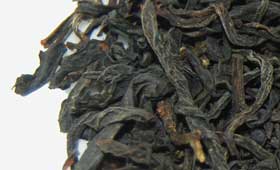 |
|
| Lapsang Souchong Tea|Special Grade | |
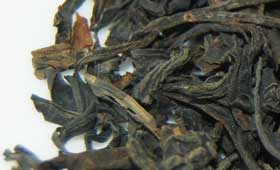 |
|
| Lapsang Souchong Tea|1st Grade |
Lapsang Souchong Tea(正山小种)
What is Lapsang Souchong Tea
Perhaps the first black tea made in the world, the best coming from the hills in north Fujian, China. It is unique large leaf tea distinguished by its smoky aroma and flavour. The tarry taste is acquired through drying over pine wood fires.
History of Lapsang Souchong Tea
The legend about the origin of Lapsang Souchong is that the smoking process was discovered by accident. An army is said to have camped in a tea factory that was full of drying leaves which had to be moved to accommodate the soldiers. When the soldiers left, the leaves needed to be dried quickly, so the workers lit open fires of pinewood to speed up the drying. The tea reached the market on time and a new flavour had been created.
The real story about why these teas from Fujian province have a smoky flavour is that in the early 17th century when the Chinese tea producers began to export their teas to Europe and America, their traditional green teas did not travel well and quickly lost quality during the 15-18 month journey across land and sea. The producers developed a method of rolling, oxidising and drying their teas so that they would hold their quality for longer. Once the teas had been oxidised, they were spread on bamboo baskets which were placed on racks in the drying room. This was built over ovens that allowed the heat to rise up through vents in the ceiling and into the drying room above. To fire the ovens, the tea manufacturers used the local pine wood from the forests that surrounded (and still surround) the factories, and as the wood slowly burned, it gave off a certain amount of smoke that was absorbed by the drying tea and gave it a lightly smoked, sappy, pine character.
In 1604, the Dutch began to import Lapsang Souchong to the West. At that time,it was regarded as a precious medicine and sold at pharmacies. The Dutch dominated the trade in Lapsang Souchong until 1669 when the English imported it on a commercial scale. By the time the English East India Company began trading in tea, lapsang Souchong was well established at the English courts, where it was no longer valued for its medicinal benefits, but was drunk as an invigorating beverage.
According to historical records,It was Princess Catherine who in 1662 brought Lapsang Souchong tea to England. She was a Portuguese and was married to Prince Charles. Her passion for Lapsang Souchong helped to promote the tea in England. Lapsang Souchong was treated as a luxury drink in England,France, Dutch and The Netherlands. In England itself,Lapsang Souchong tea is recognized as the representative of Chinese Tea and used to serve England’s Royal Family so it was known as the Royal Black Tea in England.
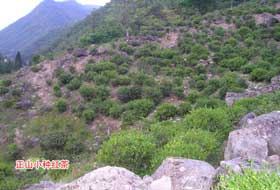 |
|
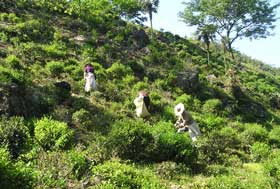 |
|
| Tea Garden in Guadun,Tongmu |
It is said the name of Lapsang Souchong came from Wuyi Rock Tea (武夷岩茶). In fact,most tea experts thought Lapsang Souchong originated from oolong tea. Its name was recorded as early as year 1734 when the name Souchong or Xiao-zhong was referred to as the best quality tea trees grown at the rocky area of Wuyi mountain which was used to produce oolong tea.
Growing Area of Lapsang Souchong Tea
The original producing area of Lapsang Souchong is Tongmu village located in Xingcun township,Wuyishan city,Fujian province. Tea gardens at Tongmu village are scattered around the Wuyi Mountain,a natural reserve. Primary forest there produces large amount of defoliation which becomes ideal fertilizer for tea trees. The forest combined with huge temperature difference and sufficient rainfall create distinctive climatic and geographic environment for the production of Lapsang Souchong.
Generally speaking,the higher the tea leaves plucked,the better the quality of finished tea. In Tongmu,Guadun, Mali and Guangping are among several famous areas which are considered to produce Lapsang Souchong of superior quality.
Tea Cultivar and Plucking season of Lapsang Souchong
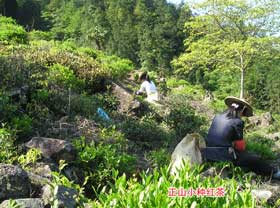 |
|
| The Caicha of Lapsang Souchong |
Due to the high elevation area and low temperature, the only cultivars that survive under the extreme conditions is the Wuyi caicha (武夷菜茶).
The first flush comes rather late because of relatively lower temperature in Tongmu. The plucking season starts around the second week of May. The earliest grown-up and fully developed buds are called Zhu-ya (驻芽, which means fresh leaves without buds)which signal the beginning of harvesting. Unlike the other Chinese black tea which is made using 1 bud and 1-3 leaves and is valued for large amount of buds. Lapsang Souchong is produced with first two to three leaves that is much maturer.
Production Process of Lapsang Souchong Tea
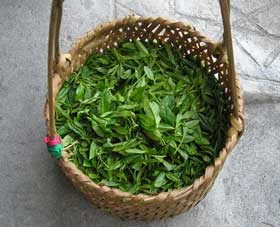 |
|
| Fresh tea leaves of Lapsang Souchong |
萎凋 (Wei diao) -Withering
After plucking,the leaves are withered over pine wood fires. In the Wuyi mountainous area,the withering has to be carried out with additional heat from burning pine firewood because of the shortage of sunny days. It is a common practice in the production of tea of Wuyi Mountain including Lapsang Souchong, The firewood is burned with a strong fire (明火 Ming-huo),generating heat to help water evaporate but which only does not contribute to the smoky flavor of end product. Tea leaves is placed on bamboo mat,piled at 3-7 cm thick,and the mat is placed on the wooden rack. At the bottom of rack,pine wood is collected and burned. In the withering room,the atmospheric temperature is controlled at 30˚C,and the tea leaves are turned over and mixed well every 20 minutes. When the leaves become soft and are not shiny anymore,they are removed from the wooden rack and placed on the floor to cool down. The leaves are then to be rolled into taut strips (called 揉捻Rou-nian,which means maceration).
发酵 (Fa xiao) - Oxidation - Production of fragrance and color
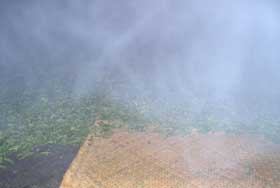 |
|
| Lapsang Souchong Withering Process |
After the rolling process,tea leaves are placed into woodenbarrels and covered with cloth to allow enzymatic oxidation to take place. At high altitudes of the mountainous area,the tea leaves are gathered together and kept in the barrels in order to maintain the optimum temperature for enzymatic reaction. When it gets cooler,the barrels will be placed near the cook-stove to keep tea leaves warm. When 80% of the tea leaves have turned into a copper color and begun to emit their own pleasant fragrance,the oxidation is sufficient.
过红锅 (Guo hong guo - chao) - Pan frying - inactivation of enzyme
Unlike any other black tea which is dried immediately after the oxidation process,Lapsang Souchong tea is instead pan fried before drying. During the pan-frying session,the high temperature in a short time will inactive the enzyme instantly,prevent prolonged oxidation and stabilize the quality and characteristic of fermented tea leaves prior to long hour drying (8-10 hours). When the pan temperature reaches 200˚C,oxidized tea leaves is placed into the pan and fried. It takes 2-3 min to give off the greenish and grassy smell of tea leaves,further improving the aromatic fragrance of tea leaves.
复揉 (Fu rou) - Second Rolling
While the fried tea leaves remain hot,it is quickly macerated for the second time. The tea leaves are rolled and tightened,more tea fluid is squeezed out and remains on the leaves’ surface. The expression of the juice over the leaf particles increases the strength (i.e. the soluble matter in the liquor when brew). In addition,it helps to absorb the smoke during the later stage.
熏焙 (Xun bei) - Drying with Small Fire
In China,regardless of what is green tea,black tea or yellow tea,the common final step is drying in the bamboo basket called Hong Long(烘笼) that is heated over burning firewood. However,for Lapsang Souchong tea,there are two critical differences which contribute to the Dried Longan aroma and smoky flavor:
- Unlikely any other kind of tea,pine tree was used as the firewood for Lapsang Souchong. Pine tree contains amber (琥珀 Hu-po), i.e., the fossilized pine tree resin.
- For the other teas,they are dried with strong flame (明火Ming-huo) throughout. However,Lapsang Souchong is dried with strong flame during the first drying stage to reduce the moisture content to 20%. Later,when the burning of pine wood is suppressed, the additional drying with smoldering fire (文火 “Wen-huo”) is carried out until the tea leaf is dried to moisture under 5%.
Due to the incomplete combustion,the smoldering pine fire generates smoke containing vaporized amber essence,which absorbed by tea leaves gives Lapsang souchong typical pine smoke flavor. The drying process takes 8-10 hours in order to ensure complete drying and develop the distinctive flavor of Lapsang Souchong. In addition,this crucial step also gives rise to the luster dark reddish color (乌润 Wu-run) of tea leaf because of amber essence absorbed by dried tea leaves.
In the past,it is widely believed that Lapsang Souchong tea has the typical dried longan flavor as the result of unique tea leaf used – it is proven to be wrong. Another tea cultivar, Zheng-he Xiao-zhong (政和小种, tea cultivar named after the Zheng-he County in Fujian Province), was used to produce both Keemun black tea and Lapsang Souchong. The result is that only Lapsang Souchong tea gave the dried longan flavor not the Keemun black tea. Apparently, the crucial drying process using smoldering pine fire is the decisive step in making Lapsang Souchong tea with unique dried longan aroma and smoky flavor.
Quality Inspection Criteria For Lapsang Souchong Tea
Shape of Tea Leaf
Leaf is thick,robust,tightly rolled taut strips, not containing buds.
Color of Tea Leaf
Leaf in dark black color looks glossy and lustrous.
Consistency of Tea Leaf
The good quality tea consists of pieces of leaf of fairly even size. If the tea is of inferior quality,the leaf is mixed with lots of bold leaves which are flat,loose and large. It is made from old leaves which contains high levels of fiber that is hard to be rolled into tight strips. When brewed,it always gives thinner taste and lighter color. In addition,poor quality tea contains a lot of broken and light pieces due to the improper handling and the finished tea that is not well sifted.
Cleanliness
The well-made tea must be free from extraneous matter such as fiber,bamboo or wooden flakes,sand or stone,dust. Stalk is unavoidable as the leaf is plucked during summer,but must be at minimal level, e.g. a few pieces per gram.
Aroma of Tea
Dried leaf gives off distinct dried Longan and smoky smells. When brewed,the liquor gives the same aromatic profile. For authentic Lapsang Souchong tea,after brewing,the dried Longan smell remains on the brewed leaves
Water Color
When brewed,the tea produces a liquor with luster and bright reddish brown color. In a cup,the authentic Lapsang Souchong produces a bright golden ring which appears near the edge of liquor to the cup. The golden ring is the sign that tea leaves are rich in theaflavins that is vital for good quality tea.
Taste
Like dates (枣 Zao),smooth,thick,the taste in an intensive strength lingers on tongue and mouth. Authentic one is far different from the commercial versions which often gives a harsh astringency or roughness in taste.
Brewed Tea Leaf
The brewed leaves of good quality show a bright brownish red color which is very consistent and even. When touched with the finger,you feel leaves are thick,soft and elastic. If the tea is of poor quality,leaves are a mixture of greenish brown and reddish color. When touched,you feel it is thin and stiff. You can also spot thick and coarse leaf veins. In addition,the green spots found on the surface of tea leaves indicate insufficient oxidation while dull,dark leaves without brightness tell inappropriate production process.
| Green Tea | Black Tea | White Tea | Yellow Tea | Oolong Tea | Dark Tea | Pu Erh | Scented | Flowering | Herbal | Tea Powder |
| Navigation |
| Home (ViconyTeas) |
| Tea Directory (VTD) |
| Tea Importers |
| Tea Exporters |
| Tea Wholesalers |
| Informative Tea Web |
| Tea Association |
| Tea Encyclopedia |
| Online Tea Shop |
| Tea Dictionary Online |
Copyright©2016 | Lapsang Souchong Tea

